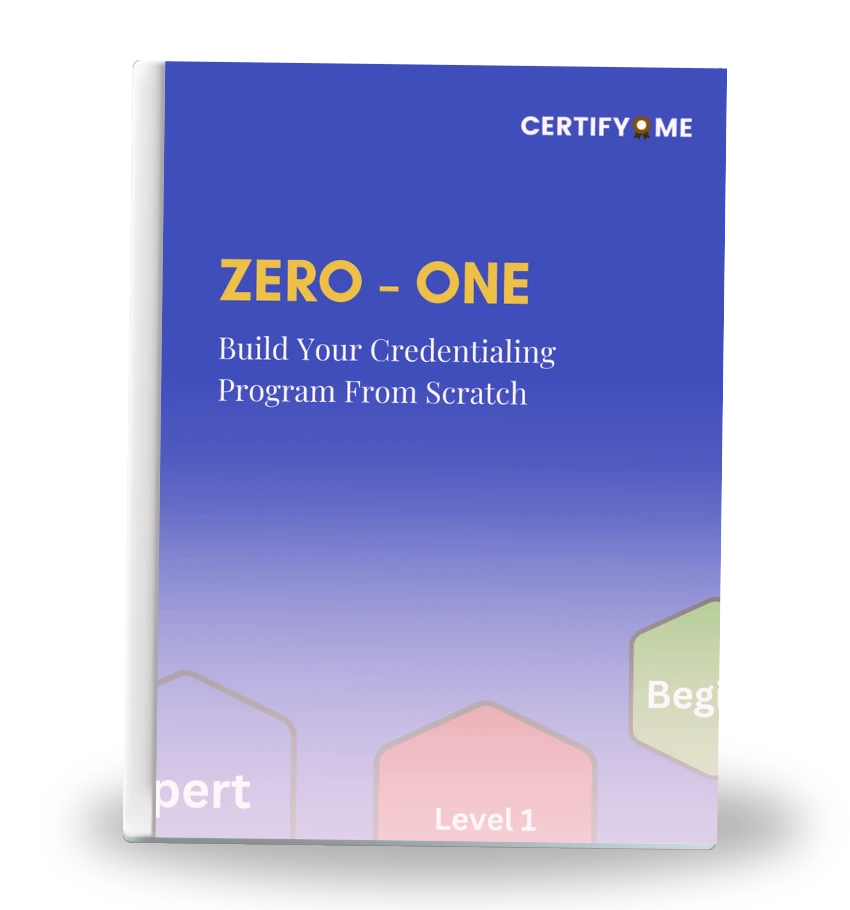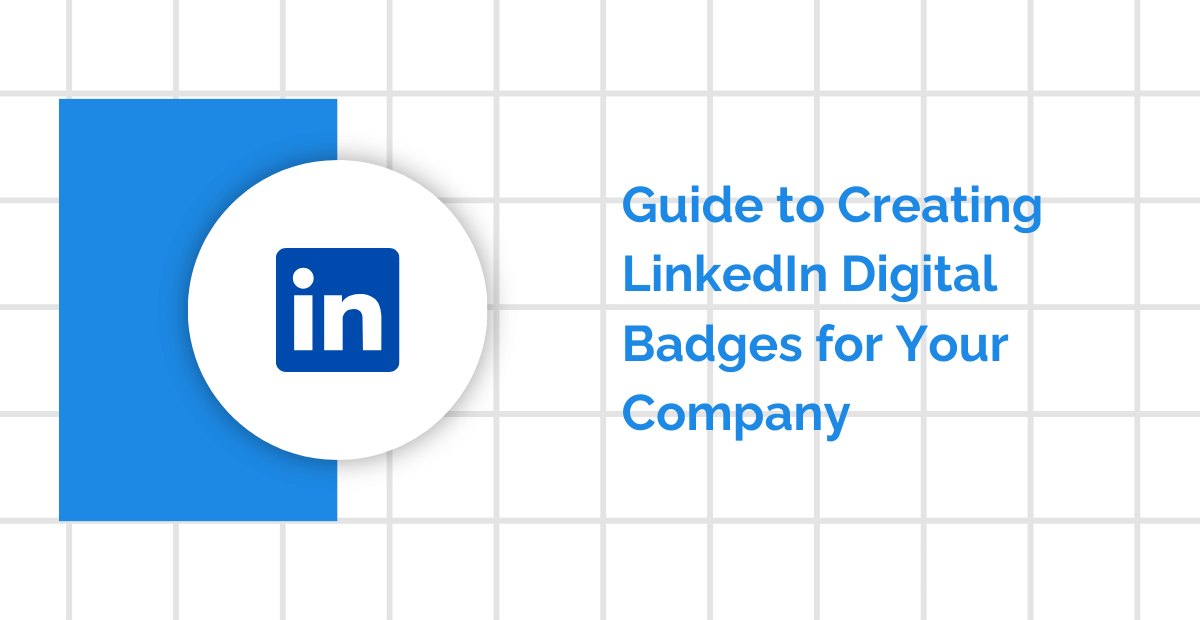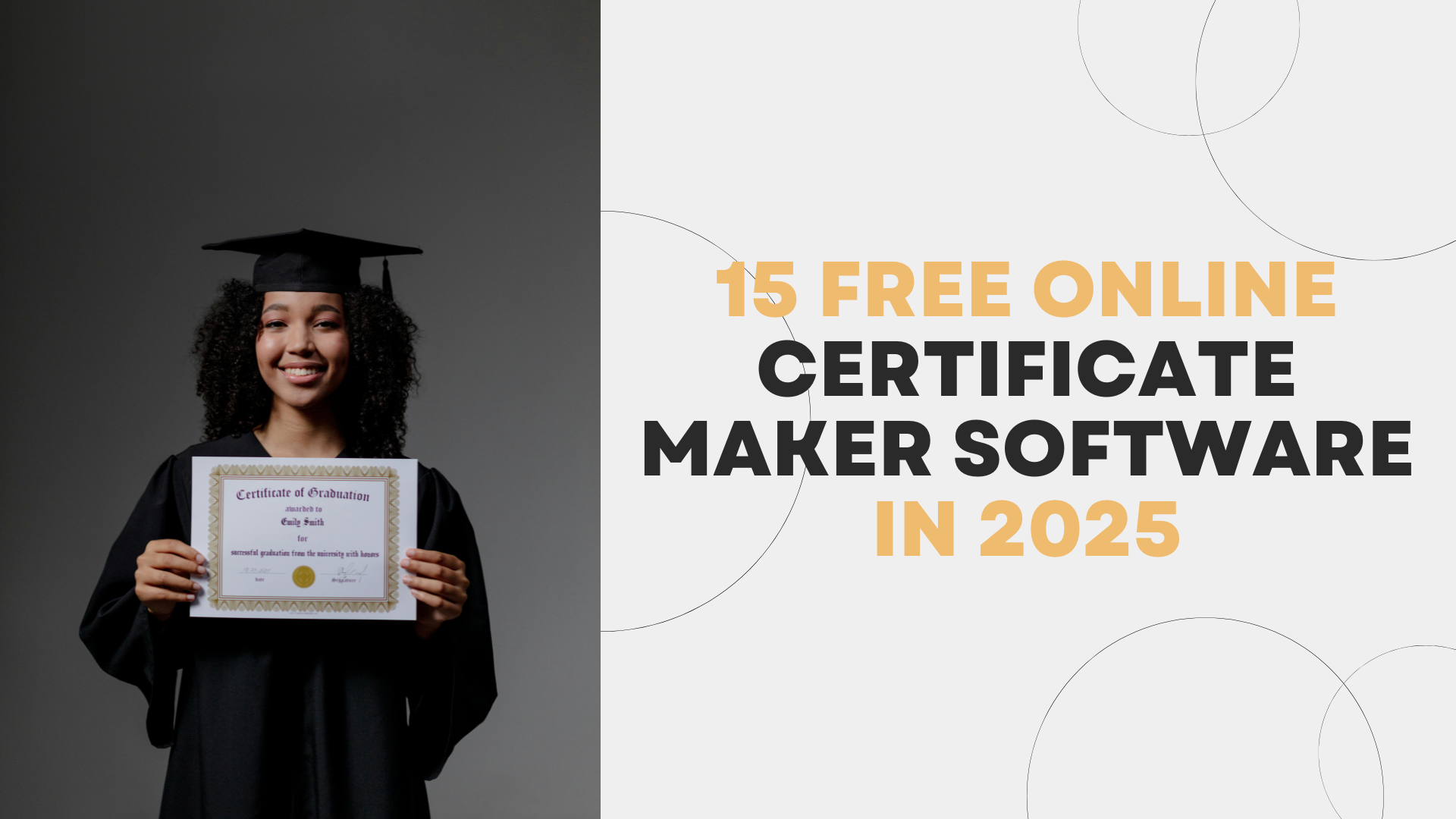Ever learned something useful but had no real way to show it?
Whether it’s a project you nailed in a workshop, a coding skill picked up over a weekend, or a leadership role you took in a campus club—those achievements matter. But the usual degree or transcript doesn’t always tell that part of your story.
That’s where digital badges and certificates come in: small but powerful tools that help learners show what they know in a way that’s easy to share, verify, and build upon.
In this blog, we’ll walk through what these credentials are, how they help students and staff alike, and why they’re becoming a go-to way to track and showcase real-world skills.
What Are Digital Badges and Digital Certificates?
Let’s start with the basics.
Imagine a student completes a short course on data visualization, participates in a leadership workshop, or develops coding skills through a summer bootcamp. These aren’t typically captured in a transcript, but they represent meaningful growth.
Digital badges and digital certificates provide a way to recognize and document these skills—in real time, and with credibility.
Digital Badge
A digital badge is a visual representation of a specific skill, achievement, or learning outcome. Think of it like a micro-credential—granular, skill-based, and often earned through smaller learning experiences.
It’s more than a graphic icon: badges carry metadata that includes the issuing organization, criteria for earning it, the date awarded, and sometimes evidence of the work completed. To dive deeper into how badges work, how they’re structured, and why they matter, check out our full guide on Digital Badges Explained.
Digital Certificate
A digital certificate is a more formal acknowledgment of a broader learning experience—like the completion of an online course, a professional development program, or a university-approved module.
They serve as digital equivalents of traditional certificates, but with one key difference: they’re shareable, verifiable, and portable.
Summarized Simply:
-
Badges = Short-form, skills-specific, focused on one capability
-
Certificates = Long-form, course-completion or program-based
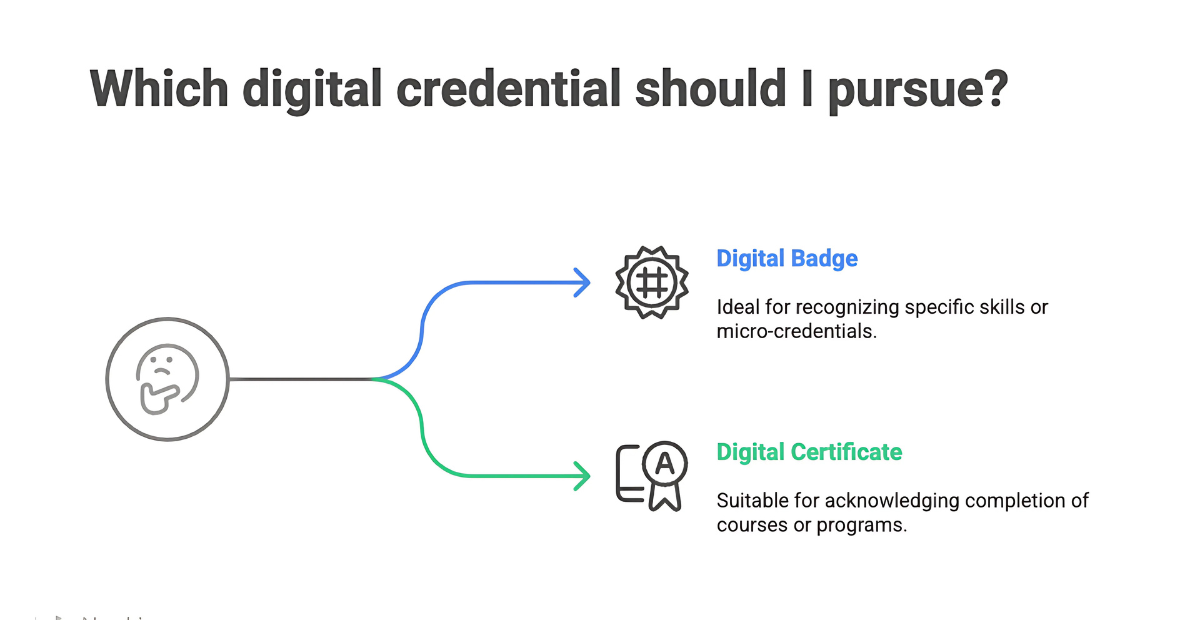
Both contribute to a more complete portrait of a learner’s abilities.
Why Higher Education Should Pay Attention
For students, digital credentials are practical. They help tell the story of their learning beyond the classroom. For institutions, they represent a strategic shift toward student-centered, skill-aware education.
Let’s look at the value these tools bring to both sides.
For University Students (18–30 age group):
-
Greater visibility in competitive job markets:
When applying for internships, entry-level roles, or freelance work, students often face the problem of proving what they can actually do. Badges and certificates provide tangible evidence of specific competencies—project management, data analysis, digital marketing, and more.
-
Customizable online portfolios:
These credentials are built to be shared. Students can embed them in their LinkedIn profiles, digital resumes, or email signatures. This builds a professional identity early on and showcases learning as a journey—not just a final degree.
-
Motivation for lifelong learning:
When learners can see progress marked and rewarded in real time, it fosters engagement. Micro-credentials, especially, provide bite-sized incentives that encourage students to take ownership of their growth.
We’ve seen how institutions are using badges to directly support student outcomes. Read more on how to Achieve Educational Goals through Digital Badges.
For University Administrators (Registrar, Career Services, Faculty):
-
Supports non-traditional learning pathways:
Not all valuable learning happens in the lecture hall. With digital credentials, universities can formally recognize co-curricular programs, service-learning, peer tutoring, research participation, and online modules.
-
Improves skill-tracking and learning analytics:
Each badge issued provides data. Institutions can assess what skills students are gaining, where gaps exist, and how learning aligns with workforce needs.
-
Enhances institutional reputation and student outcomes:
By issuing verifiable, skill-aligned credentials, universities show they’re responsive to modern hiring demands. This positions the institution as forward-thinking and student-focused.
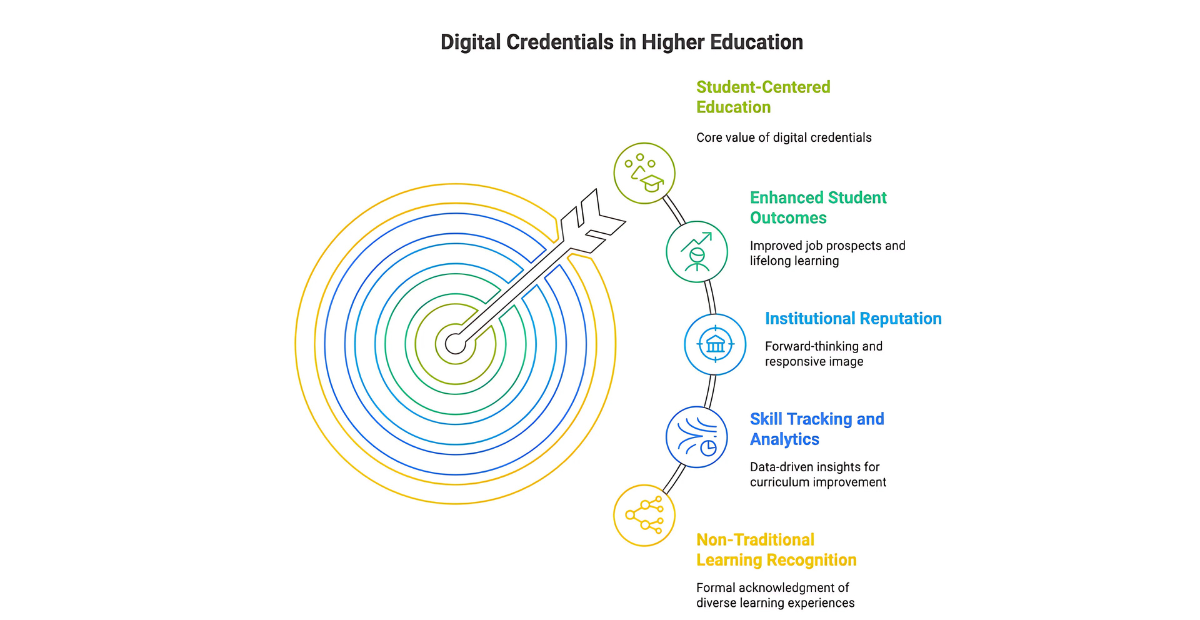
How Digital Credentials Actually Work (Without the Tech Overwhelm)
If this all sounds a bit abstract, let’s simplify how digital credentials function behind the scenes.
Imagine a digital badge as a kind of digital passport stamp. It says: “This person demonstrated this skill on this date, and here’s the proof.” But unlike a paper certificate that sits in a drawer, a digital badge:
-
Can be verified by employers with a click
-
Includes metadata that outlines who issued it, why, and how
-
Is sharable on social platforms and resumes
-
Links back to evidence—a project, assessment, or course module
This verification happens on platforms that host the badges and certificates. Common tools include Credly, Badgr, Accredible, and similar systems that integrate with LMS platforms like Canvas or Moodle.
From the institution’s perspective, this means:
-
Minimal change in workflow if integrated properly
-
Ability to issue credentials at scale
-
Insight into who’s earning what and where
Building a Living Portfolio: Why This Matters More Than Ever
Let’s use a simple analogy.
Imagine a student portfolio as a bookshelf. Traditional academic credentials—the degree, the transcript—are the heavy hardcover books. Essential, yes. But between those hardcovers, there are also pamphlets, bookmarks, and notes that often get overlooked. These smaller artifacts—badges and certificates—add texture and personality to the bookshelf.
Digital credentials help build that layered story. And because they are:
-
Modular (earned incrementally)
-
Stackable (can be grouped by topic or career pathway)
-
Connected (visible across digital platforms)
…they evolve with the student. A learner isn’t the same person in first year as they are in final year. Digital credentials reflect that growth in real time.
These credentials can also be added directly to LinkedIn profiles, making them easy for recruiters to find and verify.
What It Looks Like in Practice:
-
A communications student earns a “Public Speaking Foundations” badge after a campus workshop
-
That same student completes an online “Media Literacy” course and receives a certificate
-
She also earns a badge for peer mentoring through the student support center
-
All of these live in a clickable portfolio embedded in her LinkedIn profile or digital resume
Want to understand how organizations are using badges on LinkedIn to boost brand value and employee visibility? Take a look at LinkedIn Badges for Companies.
Now when she applies for an internship, employers don’t just see her major—they see her skills.
Addressing Concerns: Are These Just Digital Stickers?
Some critics worry that digital credentials are superficial. But here’s the thing: Their value depends on how they’re designed and issued.
Strong credentials:
-
Are tied to clear learning outcomes
-
Require assessments or demonstrable evidence
-
Are issued by trusted institutions or organizations
For institutions, it’s important not to dilute the impact by overissuing vague or unverified badges. Quality over quantity ensures employers take them seriously.
In fact, many companies already do. Major employers like IBM, Google, and Adobe recognize and issue digital badges themselves—and actively seek candidates who hold them.
We get it. The term “digital badge” can sound like something out of a gamified app or a novelty earned for showing up. Some might wonder—do they actually carry weight in the real world?
But here’s the thing: digital badges and certificates are not participation trophies. They’re verified, evidence-backed markers of ability, often linked to specific learning outcomes or skill criteria.
When issued through reputable platforms, they’re tamper-proof, easily shareable, and come with metadata that shows exactly what the learner did to earn them—how long it took, who issued it, what it covered.
Think of them like academic micro-transcripts—only much more readable and far more practical for resumes, LinkedIn, or employer portals. They don’t replace degrees or diplomas. They complement them by filling in the skill-specific gaps traditional credentials often leave out.
Still unsure what’s fact and what’s fiction when it comes to badges? Don’t miss our blog on Debunking Myths and Misconceptions about Digital Badges, where we unpack common doubts.
Still unsure?
Ask yourself: If a student leads a research project, builds a website, or earns a leadership award—shouldn’t there be a way to clearly show that? These credentials are that way.
How to Start at the Institutional Level (Without a System Overhaul)
If your institution isn’t yet issuing digital credentials, the good news is—it’s not an all-or-nothing proposition. You can begin small, test results, and expand gradually.
Here’s a basic roadmap:
Step 1: Identify Credential-Worthy Experiences
Look across your departments and student services. Ask:
-
Are there non-credit courses with assessments?
-
Are there recurring workshops or training events?
-
Are students engaging in activities that build soft skills (leadership, collaboration, digital literacy)?
Chances are, many experiences are already badge-worthy—they just lack formal recognition.
Step 2: Partner with a Credentialing Platform
Choose a digital credentialing platform that fits your scale and technical capacity. Many offer:
-
LMS integration
-
Templates and design support
-
Analytics dashboards
Step 3: Pilot with a Small Program
Start with a manageable initiative—a career readiness program, a first-year seminar series, or faculty development workshop. Monitor student response, collect feedback, and assess impact.
Step 4: Expand with Intentionality
Once piloted, expand across departments. Focus on alignment with:
-
Institutional learning outcomes
-
Career competencies (e.g., NACE competencies)
-
Equity and access across student demographics
Focus on alignment with institutional learning outcomes and frameworks such as the NACE Career Competencies, which are widely recognized by employers.
Step 5: Run a Pilot with Built-In Feedback
Choose one department or program for a short-term pilot—say, a six-week course or a capstone project.
Issue credentials, ask for student feedback, and monitor how they’re shared (LinkedIn, email, portfolios).
Check for any snags: Did the system work? Did learners feel it was meaningful?
Use these insights to tweak the approach before scaling.
Step 6: Track Outcomes and Share Results
Once the pilot is complete, document what worked (and what didn’t). Create simple reports with screenshots, student quotes, and sharing stats—these speak volumes to leadership.
Success stories—like a student landing an internship using a badge—go a long way in building campus-wide support.
Use this momentum to propose a phased expansion.
Step 7: Expand Thoughtfully, Not All at Once
Now that you’ve tested the waters, roll out credentials gradually.
Focus on programs where skills are highly visible or career-aligned—internships, service learning, student leadership.
Keep listening to feedback, adjusting as needed, and building a culture that sees credentials not as extras, but essentials.
And above all, keep it simple and scalable.
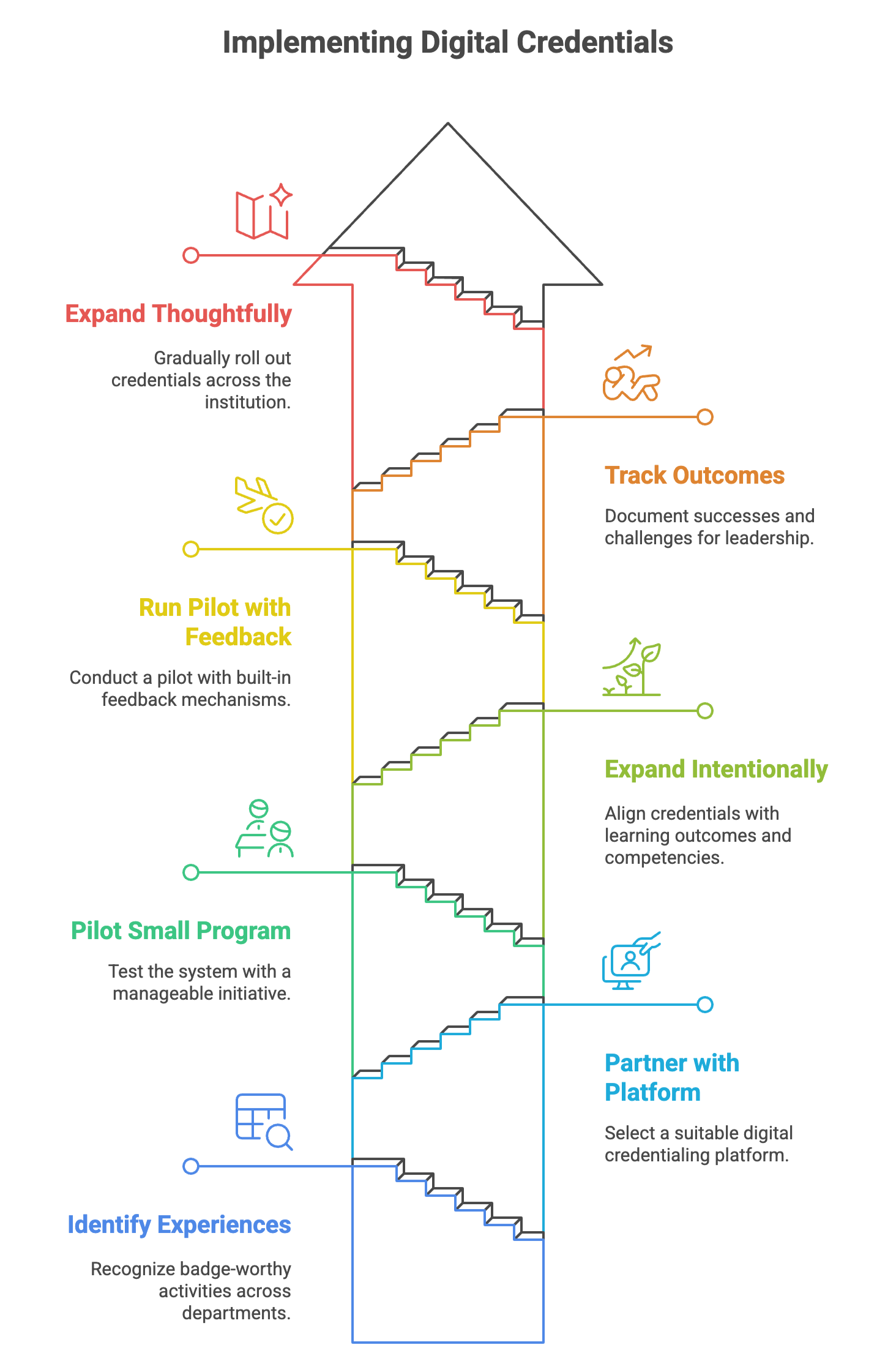
Closing Thoughts: Visibility Empowers Ability
As higher education evolves to meet the needs of modern learners and employers, recognition must evolve too.
Digital badges and certificates offer a smart, student-centered way to capture and communicate learning—especially the kind that doesn’t always fit neatly into a traditional degree. For administrators, they represent an opportunity to connect learning to outcomes, track progress, and boost student engagement.
And for students? They provide the confidence—and the proof—to say:
“I learned this. I can do this. And I’m ready to show you.”
At the end of the day, learning doesn’t always happen in neat rows inside classrooms. It’s found in internships, service projects, group work, weekend bootcamps—and often, those efforts go unrecognized on paper. That’s where digital badges and certificates quietly step in.
They empower students to take ownership of their learning journeys and give institutions a modern, efficient way to recognize growth as it happens. They’re flexible, they’re practical, and they open new doors—for learners and for the staff supporting them.
If you believe skills should be seen—not just assumed—then this is a tool worth exploring. Because when learning becomes visible, ability becomes believable.
Conclusion
Digital badges and certificates aren’t just digital stickers or shiny tokens—they’re real proof of what someone knows and can do. From soft skills like teamwork to technical know-how like data analysis, these credentials give weight to learning that often slips through the cracks.
When traditional transcripts fall short, a badge or certificate steps in with context, credibility, and clarity. And in a world where skills—not just degrees—open doors, that clarity can really count.
For students, these credentials can build confidence and boost job prospects by highlighting specific abilities that employers value. They let you tell a clearer story—this is what I did, and here’s what I learned from it.
For administrators, they offer a better way to track learning outcomes, recognize achievements, and stay aligned with workforce trends. Plus, it helps bridge the gap between what happens in the classroom and what happens after graduation.
If you’re curious about how to start issuing or earning digital credentials, platforms like CertifyMe make the whole process simple, secure, and scalable. It gives institutions a trustworthy way to issue badges and certificates while giving learners something real they can share across LinkedIn, résumés, or personal portfolios.
Whether you’re managing programs or earning your next credential, CertifyMe brings all the pieces together in one place.
Interested? Go ahead and book a demo call to see how it can work for you or your institution.

 Author :
Author : 

